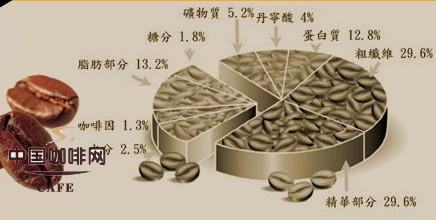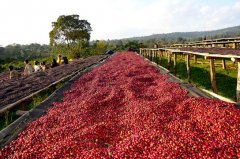The ingredients in coffee beans basic knowledge of fine coffee

Caffeine: caffeine is the most eye-catching of all the ingredients in coffee. It belongs to plant xanthamins (animal muscle components) and has the same properties as theobromine in theobromine and theophylline in green tea. The percentage reduction after baking is very small, the effect of caffeine is extremely extensive, and it will affect various parts of the human body, such as brain, heart, blood vessels, gastrointestinal tract, muscle and kidney. Appropriate amount of caffeine will stimulate the cerebral cortex, promote sensory judgment, memory, and emotional activity, make the myocardial machine more active, dilate blood vessels, enhance blood circulation, and improve metabolic function. Caffeine can also reduce muscle fatigue and promote digestive juice secretion. In addition, because it also promotes the kidney function to help the body remove excess sodium ions (chemicals that hinder the metabolism of water molecules), caffeine will not accumulate in the body like other narcotic and excitant substances (narcotic drugs, paint solvents, stimulants, etc.) and will be excreted in about two hours. The most important feature of coffee style-bitterness, caused by timely caffeine.
Tannic acid: after extraction, tannic acid will turn into a yellowish powder, which can easily blend into water. After boiling, it will decompose and produce pyrosylic acid, which will make the coffee taste worse. If you brew it well and leave it for several hours, the color of the coffee will become stronger than when it was just brewed. And it is also less tasty, so there is the saying that "it is best to drink it as soon as possible."
Fat: the fat contained in caffeine plays a very important role in flavor. It is found that there are many kinds of fat in caffeine, the most important of which are acidic fat and volatile fat. Acidic fat refers to the presence of acid in fat. Its strength varies with different types of coffee, and volatile fat is the main source of coffee aroma. Once the fat contained in roasted coffee beans comes into contact with the air, there will be chemical changes, and the taste and flavor will become worse.
Protein: the main source of calorie is protein, and like coffee brewed by trickle filter, most of the protein will not dissolve out, so no matter how much coffee is drunk, the nutrition intake is limited, which is why coffee will become a sacred food for dieters.
Sugar: without sugar, you will not only feel the bitterness of caffeine and the sour taste of tannin, but also feel sweet, which is caused by the sugar contained in the coffee itself. After baking, most of the sugar will be converted to caramel, giving the coffee a unique brown.
Minerals: there are lime, iron, sulfur, sodium carbonate, phosphorus, chlorine, silicon and so on, because the proportion is very small, affect the flavor of coffee is not big, combined to bring only a little astringency.
Crude fiber: raw bean fiber will be carbonized after baking, this carbon and sugar caramelization combine with each other to form the tone of coffee, but the fiber turned into powder will have a considerable impact on the flavor of coffee. Therefore, we do not encourage the purchase of powdered coffee beans, because it is less able to taste the flavor of coffee.
The bitterness of coffee: the color, aroma and taste of coffee are caused by some complex chemical changes that take place during roasting. Therefore, raw beans must go through appropriate chemical procedures to achieve the most balanced state of its essential ingredients in order to be regarded as the best baked beans. The aroma of coffee will change with the heat, so the baking time should be shortened as much as possible, and the heat should be controlled at the lowest temperature that can produce effective chemical composition of coffee beans, that is, the shortest time and heat, so that coffee can produce the most suitable composition ratio.
Aroma: aroma is the life of coffee quality, but also the best performance of coffee production process and roasting technology. The climate of the place of production, elevation, variety, refined treatment, harvest, storage, and the appropriateness of the baking technology of the consuming country are all conditions that determine the aroma of coffee beans. The results of gas chromatographic analysis showed that the aroma of coffee was composed of acid, alcohol, acetaldehyde, ketone, ester, sulfur compound, phenol, nitrogen compound and nearly hundreds of volatile components. Generally speaking, fat, protein and sugars are important sources of aroma, while lipids blend with the sour and bitter of coffee to form a smooth taste. Therefore, the disappearance of fragrance means that the quality is getting worse, and the relationship between aroma and quality is very close.
Important Notice :
前街咖啡 FrontStreet Coffee has moved to new addredd:
FrontStreet Coffee Address: 315,Donghua East Road,GuangZhou
Tel:020 38364473
- Prev

There are several ways to package coffee beans.
To start shopping for coffee beans, first choose a coffee shop that is booming. The freshness of roasted beans is the life of coffee, so choose a warehouse where fresh coffee beans are placed, a clean place without oil residue of old beans, no direct sunlight, and no high temperature around the store. It is also a good idea to buy from a shop that thinks it is delicious. When buying baked beans, refreshing beans can
- Next

The benefits of drinking Coffee
1. Coffee contains certain nutrients. Nicotinic acid in coffee contains vitamin B, which is higher in roasted coffee beans. And there are free fatty acids, caffeine, tannic acid and so on. 2. Coffee is good for the skin. Coffee can promote metabolic function, activate digestive organs, and has a great effect on constipation. Taking a bath with coffee powder is a kind of thermotherapy, which has the effect of losing weight. 3. Coffee
Related
- Beginners will see the "Coffee pull flower" guide!
- What is the difference between ice blog purified milk and ordinary milk coffee?
- Why is the Philippines the largest producer of crops in Liberia?
- For coffee extraction, should the fine powder be retained?
- How does extracted espresso fill pressed powder? How much strength does it take to press the powder?
- How to make jasmine cold extract coffee? Is the jasmine + latte good?
- Will this little toy really make the coffee taste better? How does Lily Drip affect coffee extraction?
- Will the action of slapping the filter cup also affect coffee extraction?
- What's the difference between powder-to-water ratio and powder-to-liquid ratio?
- What is the Ethiopian local species? What does it have to do with Heirloom native species?

